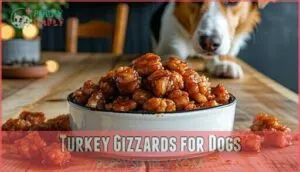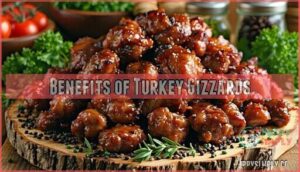This site is supported by our readers. We may earn a commission, at no cost to you, if you purchase through links.
 Yes, dogs can eat turkey gizzards, and they’re actually packed with nutrients like protein, iron, and essential vitamins that support muscle development and overall health.
Yes, dogs can eat turkey gizzards, and they’re actually packed with nutrients like protein, iron, and essential vitamins that support muscle development and overall health.
But you’ll want to prepare them correctly to keep things safe. Always cook the gizzards thoroughly to eliminate harmful bacteria, and avoid seasoning them—your pup’s stomach doesn’t need the extra spices.
Moderation is vital too, as too much organ meat can upset their diet balance. Start with small portions to verify it suits your dog’s digestion. These tasty treats can be a nutritious addition, but every dog is unique—watch for reactions and adjust as needed, considering their overall health and digestion, and the importance of moderation.
Table Of Contents
- Key Takeaways
- Turkey Gizzards for Dogs
- Can Dogs Eat Turkey Gizzards
- Benefits of Turkey Gizzards
- Feeding Turkey Gizzards Safely
- Turkey Gizzard Feeding Guidelines
- Frequently Asked Questions (FAQs)
- Are turkey gizzards good for dogs?
- What part of turkey can dogs not eat?
- Can dogs eat cooked chicken gizzards?
- Is it safe to give dogs turkey necks?
- Should I give my dog raw or cooked turkey gizzards?
- Is it okay to freeze turkey gizzards for later use?
- How often can I feed my dog turkey gizzards?
- Is there a difference between turkey gizzards and other organ meats?
- Are there any risks associated with feeding turkey gizzards to my dog?
- Are turkey gizzards suitable for senior dogs?
- Conclusion
Key Takeaways
- Cook turkey gizzards thoroughly without seasonings to ensure safety and prevent bacterial risks.
- Serve in moderation, keeping organ meats to 5-10% of your dog’s diet to avoid nutrient imbalances.
- Cut gizzards into small pieces to prevent choking, especially for smaller breeds or senior dogs.
- Watch for any allergic reactions or digestive issues when introducing gizzards to your dog’s diet.
Turkey Gizzards for Dogs
You can safely add turkey gizzards to your dog’s diet as they’re packed with protein, iron, and essential B-vitamins that support muscle development and overall health.
Packed with protein, iron, and essential B-vitamins, turkey gizzards naturally boost your dog’s health, muscle development, and vitality with every bite.
They’re best served cooked and cut into small pieces, with organ meats making up only 5-10% of your dog’s daily food intake to provide nutritional benefits without risking overconsumption of organ meats.
Nutritional Benefits of Turkey Gizzards
Inside those humble turkey gizzards lies a powerhouse of nutrition for your furry friend.
These protein-packed organs offer remarkable health benefits with minimal fat content.
- They contain 70-78% protein, making them an excellent lean protein source for muscle maintenance
- They’re packed with B vitamins (especially B3 and B12) that support energy metabolism
- They provide essential minerals like iron, phosphorus and zinc without preservatives or additives
You’re giving your dog natural, nutrient-dense nutrition with every bite.
To guarantee safety, remember to cook the giblets thoroughly. Natural, nutrient-dense nutrition.
Safe Preparation Methods for Turkey Gizzards
Your dog’s health depends on proper preparation of turkey gizzards.
Cook them by simmering for 20-30 minutes until fully done, making them safer than raw gizzards for dogs. Remove any bones thoroughly to prevent choking hazards.
For products aiding preparation, consider exploring online resources.
Watch for spoilage risks with raw options and keep portion sizes small—just 1-2 tablespoons every few days is ideal. Store leftovers in the freezer to preserve these nutritious dogsafe turkey parts.
Health Considerations for Feeding Turkey Gizzards
Several health factors must be considered when feeding turkey gizzards to your dog.
While nutritious, they need careful handling:
- Organ overconsumption can lead to nutrient imbalances
- Digestive discomfort may occur if gizzards aren’t properly chewed
- Breed differences matter—larger dogs (60-130 lbs) handle gizzards better than smaller breeds (7 lbs)
- Vomiting risk increases when organs are served whole
- Broth benefits include enhanced flavor and hydration when added in small amounts
Turkey gizzards offer a boost of nutrients, as they’re rich in protein. They provide a boost of nutrients and can be a good addition to a dog’s diet when prepared properly.
Can Dogs Eat Turkey Gizzards

Yes, dogs can absolutely eat turkey gizzards! These nutrient-packed organs are safe and beneficial for your furry friend when prepared properly.
Turkey gizzards offer outstanding nutritional value that can complement your dog’s regular diet.
| Preparation | Safety Level | Benefits | Considerations |
|---|---|---|---|
| Raw | Moderate | Maintains nutrients | Risk of bacteria |
| Cooked | High | Eliminates pathogens | Some nutrient loss |
| Whole | Low-Moderate | Natural chewing | Gizzard size matters |
| Chopped | High | Easy digestion | Better for small breeds |
When it comes to feeding dogs gizzards, consider your pet’s breed specific needs. Smaller dogs may need gizzards cut into manageable pieces, while larger breeds might handle them whole.
Watch for gizzard allergy signs like itching or digestive upset when first introducing them.
The long-term effects of including turkey gizzards in your dog’s diet are generally positive, supporting muscle development and overall health. They’re also rich in beneficial digestive enzymes that aid nutrient absorption.
Benefits of Turkey Gizzards
You’ll find turkey gizzards pack impressive nutritional benefits for your dog, including high-quality protein, iron, and B-vitamins that support muscle development and cardiovascular health.
They’re also naturally low in fat and free from additives, making them an excellent occasional treat in your pet’s balanced diet with impressive nutritional benefits.
Rich in Protein and Iron
Turkey gizzards pack a powerful nutritional punch for your furry friend.
They’re incredibly rich in protein (about 70.9% minimum), making them excellent for your dog’s muscle growth and energy metabolism.
You’ll also find they’re loaded with iron, which helps prevent anemia by boosting red blood cell production.
The high protein content supports your pup’s daily energy needs, while the iron maintains healthy blood circulation and oxygen distribution throughout their body.
For safe consumption, remember to follow important cooking and storage guidelines to prevent any health risks.
Supports Cardiovascular Health
Your dog’s heart will thank you for adding turkey gizzards to their diet.
These nutrient-packed organ meats support cardiovascular health through several key mechanisms:
- Taurine benefits include maintaining proper heart contractility and rhythm
- Rich omega-3s help regulate blood pressure and reduce inflammation
- Natural compounds support blood vessel elasticity and circulation
- Essential nutrients provide exercise support for active dogs
Turkey gizzards offer complete heart-healthy nutrition without artificial additives.
Aids in Muscle Development
Turkey gizzards are loaded with protein and amino acids, which play a pivotal role in muscle repair and growth.
They support protein synthesis, making them a fantastic addition to active dogs’ nutrition.
By aiding muscle development and exercise recovery, turkey gizzards guarantee your pup stays strong.
Incorporate them into meals as a safe, natural way to boost your dog’s health.
Natural Source of Omega-3 Fatty Acids
Omega-3 fatty acids are part of the subtle charm turkey gizzards bring to your dog’s diet.
While not abundant, these fatty acids support cognitive health and coat improvement. For a dietary balance, include turkey gizzards in small portions alongside richer omega-3 sources like fish.
- Supports brain function for alert, happy dogs.
- Boosts coat health, reducing dryness.
- Enhances overall dog nutrition safely.
Feeding Turkey Gizzards Safely
Feeding turkey gizzards to your dog can be a healthy choice, but it’s important to prepare them carefully to avoid risks.
By cooking them thoroughly and serving in moderation, you can keep your pet safe and happy.
Moderation is Key to Avoid Toxicity
Feeding dogs gizzards is healthy when you stick to moderation.
Exceeding safe serving sizes can lead to nutrient overload, causing gastrointestinal upset or long-term effects like pancreatitis.
For proper dietary balance, make gizzards only 5-10% of their diet.
Remember that the same food safety guidelines apply to your pets as to yourself.
By respecting toxicity thresholds, you avoid gizzard risks dogs might face while maximizing gizzard nutritional value for overall dog nutrition.
Cooking Methods to Reduce Bacterial Risks
Cooked gizzards for dogs are safer when you follow proper dog food cooking methods.
Simmer them for 20-30 minutes until no pink remains, guaranteeing safe temperatures to kill bacteria like Salmonella.
Using a food thermometer guarantees proper temperature.
Raw concerns? Avoid cross-contamination by cleaning surfaces and tools thoroughly.
Proper handling helps prevent bacterial contamination, protecting your dog’s health while preparing this tasty, nutritious treat.
Prioritize dog food safety and remember to always handle food with care to ensure a healthy treat.
Introducing Turkey Gizzards to Your Dog’s Diet
Start with a gradual introduction when adding turkey gizzards to your dog’s diet.
Use small amounts to monitor for allergies or digestion issues. Whether raw or cooked, portion control is key to meeting dog dietary needs.
Gizzards’ benefits for dogs include protein and vitamin boosts, making them a great supplement. Explore simple dog treat recipes for variety!
Supervising Your Dog During Meal Time
When feeding turkey gizzards, dogs might gulp them down too fast, increasing choking hazards. Keep an eye on portion control and pace to prevent speed eating.
If your pup shows food aggression, separate meal times from others. Watch their post-meal behavior for any signs of discomfort.
Supervision guarantees safe eating and supports your dog’s digestive health. Some owners offer dehydrated neck options as a treat.
Turkey Gizzard Feeding Guidelines
When feeding turkey gizzards, it’s essential to stick to moderation and keep organ meats to just 5-10% of your dog’s diet.
Properly preparing and introducing them gradually can help avoid digestive upset and guarantee your pet benefits from this nutritious treat.
Organ Meat Ratio in Your Dog’s Diet
Gizzards and other organ meats pack a punch in terms of nutrient density.
However, portion control is key to avoid toxicity risks.
Stick to 5-10% of your dog’s diet for balance.
Breed differences matter—smaller dogs need smaller servings.
Organ meats add variety to dog food but don’t overdo it.
A balanced dog diet supports safe pet nutrition.
Customizable Meal Plans for Allergies and Sensitivities
When customizing meal plans for dogs with food allergies, focus on safe ingredient sourcing and recipe adjustments.
Start by gradually introducing turkey gizzards to identify sensitivities.
Understand dietary restrictions with these steps:
- Perform allergy testing to confirm safe dog food ingredients.
- Rotate proteins like turkey to prevent new sensitivities.
- Balance meals nutritionally.
- Monitor reactions closely.
Avoiding Artificial Preservatives and Additives
Why prioritize natural alternatives for your pup’s meals?
Avoid artificial preservatives and additives in dog food ingredients by reading labels carefully.
Homemade diets offer ultimate control over ingredient sourcing, ensuring long-term health. Opt for healthy dog treats made from whole foods.
Homemade dog food can eliminate unnecessary chemicals, supporting better dog health and a happier pet. Small changes matter, and choosing the right ingredients is crucial for your pup’s well-being, which is why natural alternatives are preferred.
Enhancing Palatability for Better Appetite
Adding turkey gizzards to your dog’s diet boosts flavor while encouraging better appetite.
To enhance palatability:
- Use broth benefits by simmering gizzards and saving the liquid to moisten meals.
- Consider texture preferences—soften with warm water or bake for a crispier treat.
- Offer dietary variety by mixing with other dog-friendly foods.
Consider using nutritious food enhancers to further boost your dog’s meal.
Watch your dog enthusiastically enjoy these tasty, safe additions!
Frequently Asked Questions (FAQs)
Are turkey gizzards good for dogs?
Think of turkey gizzards as nature’s protein-packed snack for your dog.
They’re nutritious, high in protein, and safe if cooked properly.
Just serve them in moderation to avoid tummy troubles, and cut into small, chewable pieces to ensure they are a healthy and safe treat.
What part of turkey can dogs not eat?
Dogs shouldn’t eat turkey bones, skin, or seasoned parts.
Bones can splinter and cause harm, while skin and seasonings may upset their stomach.
Always stick to plain, cooked meat and avoid anything with spices or garlic.
Can dogs eat cooked chicken gizzards?
Yes, dogs can eat cooked chicken gizzards.
They’re packed with protein and essential nutrients.
Just make sure they’re plain, fully cooked, and cut into small pieces to avoid choking or digestive issues.
Moderation is key!
Is it safe to give dogs turkey necks?
Picture a turkey neck as a potential danger wrapped in a tempting treat.
While it’s meaty, the bones can splinter and injure your dog.
Always debone and consult your vet before offering it safely.
Should I give my dog raw or cooked turkey gizzards?
Cooked turkey gizzards are safer for your dog since cooking eliminates harmful bacteria.
Simmer or bake them plain and cut into bite-sized pieces.
If feeding raw, make certain of proper sourcing and introduce gradually to prevent upset.
Is it okay to freeze turkey gizzards for later use?
Freezing turkey gizzards is perfectly fine.
It keeps them fresh for later use.
Just use airtight bags or containers to avoid freezer burn, and thaw them thoroughly before cooking or serving to your dog.
How often can I feed my dog turkey gizzards?
You can feed your dog turkey gizzards 1-2 times a week as a treat.
Keep portions small—5-10% of their diet–and introduce them slowly to prevent digestive upset.
Always cook them thoroughly for safety.
Is there a difference between turkey gizzards and other organ meats?
Turkey gizzards are rich in protein and aid muscle development, while other organ meats like liver or heart provide vitamins, minerals, and healthy fats.
Each has unique benefits, so balance them in your dog’s diet to ensure a complete and healthy nutrition.
Are there any risks associated with feeding turkey gizzards to my dog?
They say "too much of a good thing can be harmful."
Turkey gizzards are safe in moderation but may cause choking, spoil quickly, or digestive upsets if swallowed whole.
Always cut and supervise feeding.
Are turkey gizzards suitable for senior dogs?
Older dogs can safely enjoy turkey gizzards, but it’s best to cook them thoroughly and cut them into small, manageable pieces.
Their chewable texture suits senior dogs, but always start with tiny amounts to prevent upset.
Conclusion
So, can dogs eat turkey gizzards? Absolutely, but only if you handle them right.
These nutrient-packed organ meats offer great benefits, like supporting muscle health and providing essential vitamins.
Just remember to cook them thoroughly, skip the seasonings, and serve in moderation to keep your dog’s diet balanced.
Start with small portions to verify they digest it well, and keep an eye on your dog for any reactions.
Prepared correctly, turkey gizzards can be a healthy, tasty treat that supports your dog’s overall well-being with essential vitamins.
- https://www.thesprucepets.com/turkey-parts-dogs-can-eat-4776956
- https://canine.care/nutrition/what-is-food-energetics-how-does-this-help-your-dog
- https://www.justanswer.com/health/2r3lx-possible-health-dangers-adverse-effects.html
- https://www.feedreal.com/glossary/turkey-gizzards
- https://www.real.dog/turkey-gizzard
















